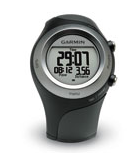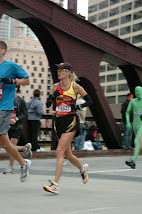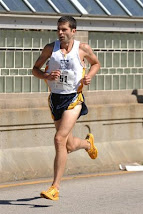
Subtitle: 2011 Rock the Parkway Half Marathon Race Report
It's About Time.
I'd like to say that I'd expected this. Or, that I carefully planned my pace, knowing my goal pace and goal splits. That I did an excellent job of preparing. None of those are true.
My workouts
since Houston have been extremely challenging, leaving me at the edge of my ability; stretching beyond; and, at times... I failed--not quite being up to the task and being forced to modify by adding some additional recovery seconds; or trying a workout again the next day. I kept thinking
Vince had mistaken me for another runner. Bill Risch, perhaps? My weekly mileage has been decent, sometimes two-a-dayers, but no single run over eleven miles since Houston on January 31. The intensity has been higher than I've ever felt in all of my training thus far, but after feeling demoralized from Houston; worried about the hills; I'd checked my ego at the door and had no expectations today. In fact, I visualized myself swallowing my pride completely, and walking it in.
I've never actually run a half marathon as fast as I could, and this course certainly wasn't making me think it was going to go well. My last few weeks at work have been unbearably stressful, extending me through too many hours and too many emotional crises. I never prepared for this race mentally; and I finally left my office at 8:30 PM last night having not done the first thing to prepare. I felt rushed and incomplete. Laying in bed last night at 9:45 PM, setting my alarm for 4:50 AM, I realized I had indeed forgotten something very important in my race preparation. I'd forgotten to eat dinner. I'd had a small microwave meal at 11:45 that morning, and absolutely nothing since. That's right, while everyone else was carbo-loading, I accidentally fasted. What an idiot I am. I was too tired, too lazy and too depressed to do anything about it and just went to bed hungry.
Driving to the race this morning, I realized I'd forgotten one other key element--where the race actually started and where I was supposed park. Whoops.
Walking around prior to race start and seeing so many in their Boston jackets and snappy race singlets from this club or the other, I sunk even lower. I looked like homeless person, wearing ill-fitting and ill-matching throw-away clothes I'd picked up at Salvation Army and never needed due to the heat in Houston. I didn't even know where to line up. Everyone was abuzz with excitement... but me. I wanted to hide in a crack in the pavement. Could I break 2 hours? 1:50? Someone sent me an email last night and asked me my goal time. I never responded, expecting my finishing time to be an embarrassment. However, I wanted to learn what a half marathon felt like. And I was determined to go through this experience--whatever it brought me.
I selected a spot next to the person carrying the 1:45 Pacer sign. Not that I expected to RUN a 1:45, in fact, I knew that I couldn't. I just figured that people would line up too far up front, and that I'd just see if I could find a pace near that in the beginning and hang on as long as I could.
The horn went off, and there we went. I felt unbearably boxed in. I couldn't move. I struggled to find a place where I wasn't at an 11:00 pace. I darted around people, hopped up on the curb, did what I needed to do to find any position that wasn't a sardine-in-a-can. Then I did everything I could to drop my pace. My first mile was the slowest as a result, 8:11 (a wide range of walking to speeding up).
By Mile 2, we were climbing the first part of the big hill, and I was gradually finding a rhythm. It was still pretty crowded, and somewhere in here, I grabbed a few sips of Gatorade--my one of two water stops. I wasn't actually thirsty--per se--it just happened to be the first race in a long time I was by some miracle actually on the same side as the first water stop. This was symbolic. I heard my watch chirp, and it said 7:54 (my second slowest mile). "Whoops, that was a little too fast," I thought. I was certain I'd just blown it and would pay for it later. Oh well.
Mile 3 and we were still climbing, and I was feeling the hill, but we had a few breaks in it, allowing me to recover before the next rise began. My center felt really strong, and I finished this mile (and the big hill) in 7:51 (my third slowest mile). I cracked my first smile as somewhere in here were a group of people holding signs and cheering enthusiastically. The one sign I read said, "Run, Total Stranger, Run!" I loved it! Thank you, Total Strangers!
Mile 4 at last was a welcome relief from the hill, and I felt myself picking up a little bit of speed. I finished in 7:27 and couldn't believe the race was almost 1/3 over already. I tossed my gloves and began to relax and be happy. This wasn't actually going to be so bad. The worst had to be behind me, the weather was perfect (mid-40s) and the miles were seductively easy (go figure!). I hadn't really had the feeling of working hard yet.
Somewhere in Mile 5 I grabbed a sip of water--one sip--and that was my last water stop. I just didn't need it or want it, and my excitement was growing. I also stopped looking at my watch. I'd found the cadence and the feeling I wanted to maintain for the race, and didn't really have any expectations as to what it was. It was simply the right pace and I knew this by feel. We began to weave our way through the turns, and I clipped this mile at 7:41 and Mile 6 at 7:37 and Mile 7 in 7:46. There were little hills here and there, but both uphill and downhill, and nothing really took too much out of me. I'd settled and was running in the open at my own speed. Right at the hairpin turn, I saw Travis, who shouted out to me. He wasn't that far ahead. I wondered if I could catch him. He was running strong!
Mile 8 found me back down Ward Parkway, and I was marveling at how well I felt. I just felt strong and relaxed, and was waiting to start feeling bad. I wanted to be sure to contain the "bad" to the last 5K, thinking I could probably push through that in 25-27 minutes worst-case. Mile 9 rolled by in 7:42 (but I hadn't seen my watch in miles).
Now, I was really keen on Mile 10. Where the hell was it? This was where I was going to allow myself to start feeling bad--it was OK to feel bad now. It was also where I was going to look at my watch and start calculating what I thought my finishing time might be. But, I never saw the marker. This was the lowest point of the race emotionally for me (save for the start). I was not fading; but I keenly needed to know I only had 5K to go. By the time my watch read 10.5 miles, I decided I must have missed it completely. The problem here was, I needed to know where I was on the course relative to 5K-left-to-go to know where I was in the finishing time. During the race at this point, I couldn't even calculate to a ten minute predicted finish since I missed this key mile-marker. "Oh well," I muttered to myself, "it's not like it matters. This isn't the goal race." I finished mile 10 in 7:38.
Now things were getting interesting. There was a girl who had switched positions with me several times. She was attacking the hills and gaining on me, and then going downhill conservatively where I would take the lead. She looked very strong, and I decided it would be a good idea to try and beat her. And then, the unexpected big hill arrived. I hung onto her and stayed just a few feet behind, and was making up my mind how to pass her and stay past her. I decided I would rest at this pace, and then blow by her and try to keep the pace strong so she wouldn't regain it. Then, something amazing happened. A man ran by on my left with a notably faster pace than I was running, and I decided to go with him. We blew by her and I hung on long enough to feel I'd accomplished this pass successfully. I never saw her again.
At this point is the only complaint I have about this race--the slowest of the 10K-ers (who started 15 minutes after the half-marathoners) were walking it in--sometimes three abreast in the middle of the course. Ordinarily, at this pace for a half-marathon (my average moving pace was 7:39 overall), one doesn't expect to negotiate dozens of walkers and / or extremely slow joggers in the middle of the road. If the race organizers could do anything better next time--it would be to start the 10K-ers at a much different time (earlier or much later) to avoid the half marathoners as much as possible.
Mile 11 was 7:50 and Mile 12 was 7:45, and the last hill was behind me. I now glanced down at my watch and knew I was somewhere in the low-to-mid 1:40's for a finishing time. I'd guessed about 1:43-1:44, and this was the first inkling I had that the 1:44:00 year's goal was actually within my reach. I was shocked. I got chills. A little downhill, a little kick and a possible Travis sighting ahead, I finished Mile 13 in 7:14 and just went for it to the finish line. I punched my watch after running over ALL the cables (four? five? six? how many do they need?), and then lost my Garmin screen completely. Figures, touchy thing.
I breathed. It was over. I might have actually run a 1:44:00 or better, but I wasn't sure. I looked up and saw Travis. A few brief words of congratulations back and forth, I found my finishing time after multiple pushes and taps and we compared. He'd punched his watch exactly ten seconds before I did, reading a 1:41:15 and mine read a 1:41:25.
Rock The Parkway Half Marathon 2011 by agardn07 at Garmin Connect - Details
Hell, yes. While I still await the
official results, I know I have plenty of buffer and resoundingly qualified for the
2012 New York Marathon. While stunned, I am very happy. I'll post pictures when some are available.
Other official results (1:41:21)
here. Looks like I took 3rd in my division out of 171, so not too bad.

















